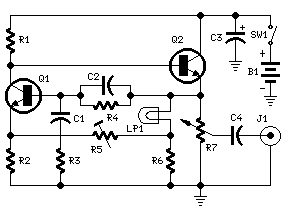1KHz Sinewave Generator Circuit
Simple circuitry, low distortion, battery operated
Variable, low impedance output up to 1V RMS
Parts:
R1 5K6 1/4W Resistor
R2 1K8 1/4W Resistor
R3,R4 15K 1/4W Resistors
R5 500R 1/2W Trimmer Cermet
R6 330R 1/4W Resistor
R7 470R Linear Potentiometer
C1,C2 10nF 63V Polyester Capacitors
C3 100�F 25V Electrolytic Capacitor
C4 470nF 63V Polyester Capacitor
Q1,Q2 BC238 25V 100mA NPN Transistors
LP1 12V 40mA Lamp (See Notes)
J1 Phono chassis Socket
SW1 SPST Slider Switch
B1 9V PP3
Clip for 9V PP3 Battery
Circuit description:
This circuit generates a good 1KHz sinewave using the inverted Wien bridge configuration (C1-R3 & C2-R4). Features a variable output, low distortion and low output impedance in order to obtain good overload capability. A small filament lamp ensures a stable long term output amplitude waveform. Useful to test the Audio Millivoltmeter, Audio Power Meter and other audio circuits published in this site.
Notes:
The lamp must be a low current type (12V 40-50mA or 6V 50mA) in order to obtain good long term stability and low distortion.
Distortion @ 1V RMS output is 0.15% with a 12V 40mA lamp, raising to 0.5% with a 12V 100mA one.
Using a lamp differing from specifications may require a change in R6 value to 220 or 150 Ohms to ensure proper circuit's oscillation.
Set R5 to read 1V RMS on an Audio Millivoltmeter connected to the output with R7 fully clockwise, or to view a sinewave of 2.828V Peak-to-Peak on the oscilloscope.
With C1,C2 = 100nF the frequency generated is 100Hz and with C1,C2 = 1nF frequency is 10KHz but R5 is needing adjustment.
High gain transistors preferred for better performance.
author:RED Free Circuit Designs,
website: http://www.redcircuits.com

